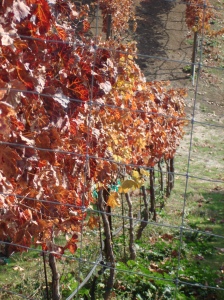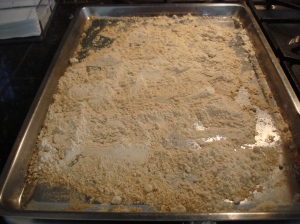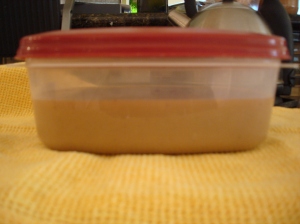 [/caption]
[/caption][caption id="attachment_1085" align="aligncenter" width="240" caption="Indoor autumnal scenery"]
 [/caption]
[/caption][caption id="attachment_1086" align="alignright" width="240" caption="And yet more autumnal scenery"]
 [/caption]
[/caption]Guess what I did today? I made the gravy for Thanksgiving! This recipe does not involve jarred or powdered or canned gravy that you enliven with...with...other stuff. Rather, this uses actual turkey parts you roast yourself. Is it cost effective? Not particularly. Is it worth every penny? You bet your sweet bippy.
And yes, it is only November 10, but gravy can be kind of hard--it has to be done at the last minute, and it is subject to the whims of your drippings, your flour, your whisking, and your attention span (and maybe your pre-dinner wine consumption?). When you are making a multi-course dinner for 11 of your closest friends, making the gravy right before dinner is served tends to be a teensy bit stressful. Lumpy? Runny? Not
 enough? The mind reels. For the last few years I have followed the recipe in Ann Hodgman's Beat This for Chicken Gravy, except I doubled it (we are big gravy fans, and we like gravy with the leftovers, thank you very much) ad libbed it a little bit, and ended up with Make-Ahead Turkey Gravy. This is a bit time consuming, but think how glad--indeed, how thankful--you'll be that you've freed up all that pre-dinner potato mashing, cream whipping time.
enough? The mind reels. For the last few years I have followed the recipe in Ann Hodgman's Beat This for Chicken Gravy, except I doubled it (we are big gravy fans, and we like gravy with the leftovers, thank you very much) ad libbed it a little bit, and ended up with Make-Ahead Turkey Gravy. This is a bit time consuming, but think how glad--indeed, how thankful--you'll be that you've freed up all that pre-dinner potato mashing, cream whipping time.First of all, buy some turkey parts, say up to a month before Thanksgiving. This time I bought three turkey thighs and three turkey necks (mostly because all they had at Safeway was thighs and necks). Thighs make a good amount of drippings, and I used the necks for the stock . You could use wings and giblets (not the liver), too, for the stock, or use drumsticks for roasting. See what they have at the store.
[caption id="attachment_1078" align="alignleft" width="300" caption="Flour lightly tanned from the oven"]
 [/caption]
[/caption]Preheat the oven to 425 degrees.While you get the thighs ready, put 12 Tbl. of flour on a cookie sheet and put in the preheated oven for 8 minutes. Remove from oven, stir flour to mix the browned and still white flour together, and return to oven for 4 more minutes. Set aside. Place the thighs, skin side up, on a rack in a roasting pan. Spread them with a little butter, sprinkle with salt and pepper. Put a little water in the bottom of the pan so that the drippings don't smoke and scorch and make your oven messy, to boot. Roast the thighs at 425 degrees for about an hour, maybe a little more, depending on how big they are.
[caption id="attachment_1079" align="alignright" width="300" caption="How your thighs should look when they are done (well, the turkey's thighs)"]
 [/caption]
[/caption]While the thighs roast, make the stock: place in a large stock pot the turkey necks, 2 or 3 carrots cut in chunks, 3 sticks of celery in chunks, 3 large onions cut into slabs, 5 whole cloves garlic, peeled, 2 tsp. whole peppercorns, handful of fresh parsley, 1 Tbl. dried thyme, 2 tsp. dried sage, approx. 30 oz. chicken broth (canned is fine!), 4 cups of water, and 3/4 cup vermouth or white wine. Bring to a boil, then let simmer for a couple of hours. Skim the scum on the surface if you need to. Let the stock simmer until reduced by about one-quarter. When it's done, pour the stock and veggies through a sieve into a jug or bowl. Press down on the veggies to get all the juices out, then discard the veggies. Keep the stock handy.
[caption id="attachment_1080" align="alignleft" width="300" caption="Stock ingredients"]
 [/caption]
[/caption]Remove the rack and cooked turkey from the roasting pan. Place the roasting pan on a low flame on the stove, and start to stir and scrape up the browned bits on the bottom of the pan (the "fond"). If you don't have enough drippings, which happens often, add some canola oil, a little at a time, until you have approximately 10 or so tablespoons of drippings and oil combined. Increase the heat, keep stirring, and listen for the drippings to start to sizzle. Using a fine sieve, start to sift in the
[caption id="attachment_1081" align="alignright" width="300" caption="Heating the drippings"]
 [/caption]
[/caption]browned flour you made earlier, a few tablespoons at a time, into the drippings, stirring the flour and drippings into a paste. Keep doing this until you have just about 2 Tbl. of flour left, and reserve the 2 Tbl. of flour. If you are having a hard time making the paste (the "roux"), you could add a little stock to moisten things up and help make the paste. When all (except the 2 Tbl.) of the flour has been incorporated, start to add the warm (or hot) stock, a ladleful at a time, to the roasting pan. Start whisking, making sure to keep the growing gravy moving. Lower the heat if necessary, and keep adding stock until the consistency is, as Ann
[caption id="attachment_1082" align="alignleft" width="300" caption="Finished product"]
 [/caption]
[/caption]Hodgman says, gravy-ish. If it's become too thick, add a little more stock. If it doesn't seem thick enough, sieve the remaining flour, a little bit at a time, into the gravy, whisking well. Taste the gravy--more salt? pepper? vermouth? garlic powder? thyme? Keep tasting til you're happy--you'll know what it needs.
Let the gravy cool, transfer to a freezer-safe container, and freeze until Thanksgiving (I wouldn't freeze it for longer than a month). Let thaw overnight in the fridge. An hour or two before dinner, place thawed
[caption id="attachment_1083" align="alignright" width="300" caption="Ready for the freezer"]
 [/caption]
[/caption]gravy in a saucepan. It may be much thicker now, so feel free to add some canned chicken broth, a little at a time, to thin it. Heat slowly over low, then medium-low, heat. Taste for seasoning again. Pour into a warmed gravy boat. Be thankful.
1 comment: